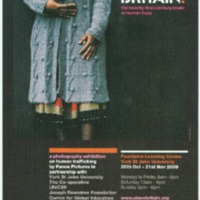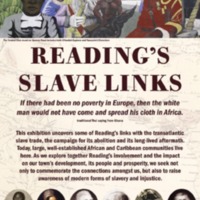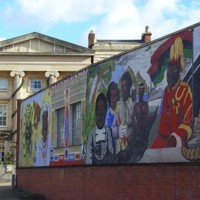
Slave Britain: The 21st Century Trade in Human Lives
This photographic exhibition focused on human trafficking was produced by a partnership of Panos Pictures, Anti-Slavery International, Amnesty International, Eaves and UNICEF. Photographer Karen Robinson’s portraits and tales of women trafficked into prostitution explore the devastating impact on their lives. Also on display were David Rose's panoramic photographs of the ordinary British streets where the stories of modern-day slavery have been played out. The photographs were mounted on a cage-like structure which was specially designed for the exhibition at St Paul's Cathedral. The exhibition was also shown in Edinburgh, Hull and Warsaw, and in 2008, in York.

Reading's Slave Links
This exhibition from Reading International Solidarity Centre (RISC) in collaboration with local communities uncovered Reading’s links with the slave trade, the campaign for its abolition and its aftermath. Exploring Reading’s involvement in historical slavery and the impact on the town’s development, the exhibition focused on, for example, wealthy families in the area, the role of the Royal Berkshires in Caribbean colonies, and the story of Mary Smart, the earliest known Sierra Leonean resident in Reading. The project also sought to raise awareness of modern forms of slavery and injustice. It included workshops, a conference, and a quiz.

Reading Mural Black History
The project began in 1987 when Central Club approached Reading Borough Council about the possibility of a mural project. A project steering group was set up consisting of representatives of Central Club, Reading Borough Council and Berkshire County Council (who then ran Central Club as part of the Youth and Community Service). It was agreed that the project should aim to achieve a number of objectives:
· A high quality visual artwork
· Community involvement – both Central Club members and the wider community
· Reflecting African Caribbean culture, since Central Club had a high proportion of African Caribbean members
In 1988 a number of artists were interviewed, and Alan Howard was offered the commission. Alan was keen to encourage the involvement of Central Club members both in a consultative capacity but also more directly in the design and execution of the mural. An apprenticeship scheme was established, where a limited number of people were offered the opportunity to work alongside Alan and receive training in planning, design and technical skills.
The process of planning the mural involved a number of steps:
· Wide ranging discussions with Central Club members and the wider African Caribbean community
· Consultation with funders – Reading Borough Council and Earley Charities
· Consultation with neighbouring residents and businesses in the London Street area
Out of this process the theme for the mural emerged, and it was agreed that the mural should depict the positive role that black people have played throughout history, including in Reading itself. The mural therefore includes figures such as Harriet Tubman, Martin Luther King and Bob Marley as well as Reading-based people involved in founding Central Club. The final panel of the mural and the various symbols look to the future and depicts a number of tools – positive and negative – that people use to shape the future.